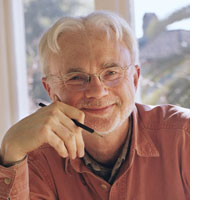John Adams: Tim McAllister on Adams's New Saxophone Concerto

<dir=ltr align=left>With the premiere of the Saxophone Concerto right around the corner, the eminent saxophonist chimes in on the new work…and the composer
<DIR=LTR align="left">B&H: Which genre does the Saxophone Concerto most reflect?
TM: As Adams shared in his Richard Scheinen interview, as well as his Grammophone interview, the piece is inspired in part by his love of progressive jazz from the 50s and 60s, joined by the fact that his father played some saxophone, as well as a former clarinet teacher of his, who he heard play saxophone in the Boston Symphony during his youth. The work is not intended as jazz or a "third stream," but its link to John's early listening experiences and his view of the instrument as emblematic to the entirety of the jazz genre is undeniable.
B&H: What is the saxophone’s relationship with the ensemble in this work? How is it treated?
TM: The piece certainly seems on the surface linked to the sound world of City Noir, with its obvious saxophone connection, but it goes further in treating the instrument as a focal point, equally, in both solo and ensemble passages, rather than an exotic orchestral sonority alluding to cinematic culture. I hear the thread of the saxophone as the "point man" for some rather challenging, polyrhythmic orchestral writing throughout—the sax is the center of the architecture rather than simply being a detached personality out in front of the ensemble. The work serves as a natural outgrowth of the saxophone writing (rather complex, by the way) within, say, Nixon in China and Fearful Symmetries. City Noir took that writing to the precipice, and now the Concerto puts the instrument firmly in the limelight.
B&H: What is your stylistic approach to this work? Is this new ground?
TM: Interestingly, John has had little affiliation or affection for the predominant 1950s "French School" sonority and approach that is a stereotype of the classical realm of saxophone playing. He has had quite an aversion to some of the expressive clichés from that style, particularly with regards to a pervasive, fast and regulated vibrato. He mentioned to me that he wanted us to forge a "new American sound" that draws upon my strengths as a classical musician merged with a modern, crossover sentiment that alludes to Phil Woods, Paul Desmond, or even Stan Getz, whose album "Focus" he is quoted as saying was a big influence on this new Concerto. He had even suggested we co-author a performer’s note in the final publication of the solo part which outlines the stylistic concepts John and I have arrived at: something that, perhaps, merges "cool jazz" sensibilities with more of the American School classical (and even music theater/Broadway) concept of sound as exhibited by mid-twentieth-century players/teachers heard in New York City, Detroit, and Chicago. Interestingly, this was the very thing I was going for in City Noir, which John has always liked. At times in that piece I attempt to channel Bernstein's sax, other times Charlie Parker's bebop, and, of course, two of my biggest influences, the legendary classical players Donald Sinta and Fred Hemke—major architects of the "American" classical sound.
B&H: How is the Saxophone Concerto different from the established repertoire?
TM: One will not find many of the stereotypical pyrotechnics that have dominated contemporary classical sax concert repertoire since the 1970s, such as multiphonics, extreme altissimo, percussive slap tongue effects, among other extended techniques. The piece is rather traditional and idiomatic in its treatment of the instrument. Its virtuosity centers around conveying the complex range of characters from section to section, the ability to command a disjunct, intervallic palette, and, in many instances, circular breathing is a necessity to tackle the huge, sustained passages throughout. Moreover, the scope of the work—close to 30 minutes—makes for a physically demanding work, and, easily, the most important work for saxophone in this young century.
Photo: Margaretta Mitchell
